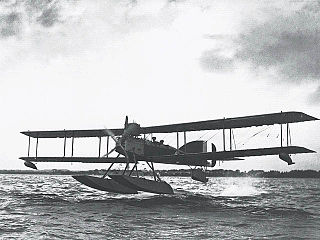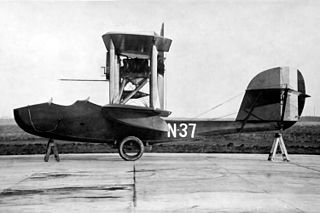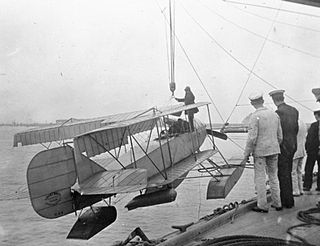Operators

| Admiralty Type C | |
|---|---|
| Role | Experimental torpedo bomber |
| National origin | United Kingdom |
| Manufacturer | Sopwith Aviation |
| First flight | 1914 |
| Introduction | November 1914 |
| Retired | 1916 |
| Primary user | Royal Navy Air Service |
| Number built | 3 |
The Sopwith Admiralty Type C was an early British seaplane designed and built by Sopwith Aviation to drop torpedoes. A single engined tractor biplane seaplane, three were delivered to the Royal Navy in November 1914 but proved unable to lift a torpedo. [1]
The Admiralty had ordered a special torpedo carrying biplane (the Sopwith Special torpedo seaplane Type C, serial number 170) in February 1914 and followed it with an order in July 1914 for three similar Type C seaplanes (serial numbers 157, 158 and 159). [1] The specification called for folding wings, bomb gear, a gun and radio. [2] Work started at the Sopwith factory at Kingston-upon-Thames on 5 April 1914 and the three Type Cs, powered by a 200 hp Salmson (Canton-Uneé) piston engine, were completed by October. [2] They went to RNAS Calshot for evaluation in November 1914. [1] The Special, tested that July, had failed to lift a torpedo and the new Type Cs were little better, failing to take off under load: [2] 157 could not get airborne with a 14" Whitehead torpedo and the other two had similar poor performance. [1] 158 was accepted by the service on 4 February 1915 but it sank following a forced landing a few days later on 8 February. [1] The two survivors, 157 and 159, were withdrawn from service at the end of 1915. [1]
Related lists

The Sopwith Aviation Company later Sopwith Aviation & Engineering Company was a British aircraft company that designed and manufactured aeroplanes mainly for the British Royal Naval Air Service, Royal Flying Corps and later Royal Air Force in the First World War, most famously the Sopwith Camel. Sopwith aircraft were also used in varying numbers by the French, Belgian, and American air services during the War.

The Sopwith Pup was a British single-seater biplane fighter aircraft built by the Sopwith Aviation Company. It entered service with the Royal Flying Corps and the Royal Naval Air Service in the autumn of 1916. With pleasant flying characteristics and good manoeuvrability, the aircraft proved very successful. The Pup was eventually outclassed by newer German fighters, but it was not completely replaced on the Western Front until the end of 1917. Remaining Pups were relegated to Home Defence and training units. The Pup's docile flying characteristics also made it ideal for use in aircraft carrier deck landing and takeoff experiments.
The AD Seaplane Type 1000 also known as the Admiralty Type 1000 and the AD.1 was a British seaplane of the First World War designed to attack German warships. When it first flew, it was the largest British aircraft yet to take to the air.

The Sopwith Tabloid and Sopwith Schneider were British biplanes, originally designed as sports aircraft and later adapted for military use. They were among the first types to be built by the Sopwith Aviation Company. The "Tabloid", so named because of its small size, caused a sensation when it made its first public appearance.

HMS Ark Royal was the first ship designed and built as a seaplane carrier. She was purchased by the Royal Navy in 1914 shortly after her keel had been laid and the ship was only in frames; this allowed the ship's design to be modified almost totally to accommodate seaplanes. In the First World War, Ark Royal participated in the Gallipoli Campaign in early 1915, with her aircraft conducting aerial reconnaissance and observation missions. Her aircraft later supported British troops on the Macedonian Front in 1916, before she returned to the Dardanelles to act as a depot ship for all the seaplanes operating in the area. In January 1918, several of her aircraft unsuccessfully attacked the German battlecruiser SMS Goeben when she sortied from the Dardanelles to attack Allied ships in the area. The ship left the area later in the year to support seaplanes conducting anti-submarine patrols over the southern Aegean Sea.

The Short Admiralty Type 184, often called the Short 225 after the power rating of the engine first fitted, was a British two-seat reconnaissance, bombing and torpedo carrying folding-wing seaplane designed by Horace Short of Short Brothers. It was first flown in 1915 and remained in service until after the armistice in 1918. A Short 184 was the first aircraft to sink a ship using a torpedo, and another was the only British aircraft to take part in the Battle of Jutland.
The Short Admiralty Type 74 was a single-engined biplane tractor seaplane with non-folding wings, which saw service with the Royal Naval Air Service during the First World War.
The Sopwith Admiralty Type 807 was a 1910s British biplane seaplane designed and built for the Admiralty by the Sopwith Aviation Company.

The Sopwith Admiralty Type 860 was a 1910s British biplane seaplane torpedo bomber designed and built for the Admiralty by the Sopwith Aviation Company.

The Short Type 166 was a 1910s British two-seat reconnaissance, bombing and torpedo-carrying folder seaplane, designed by Short Brothers.
The Wight Twin was a British large twin-engined aircraft of the First World War. It was a twin-engined, twin boom biplane. One was built as a landplane for France, while three more similar aircraft were built as Seaplanes for the British Royal Naval Air Service. Both versions were unsuccessful and saw no service.

The Norman Thompson N.1B was a prototype British flying boat fighter aircraft of the First World War. A two-seat single-engined pusher biplane, a single example was built in 1917, but no production followed.
The Sopwith Gunbus was a British fighter aircraft of the First World War. It was a single-engined pusher biplane based on a floatplane built by Sopwith before the war for Greece. Small numbers were built and used by the British Royal Naval Air Service, mainly as a trainer.

The Sopwith Bat Boats were British flying boats designed and built from 1912 to 1914. A single-engined pusher biplane, the Bat Boat was the first successful flying boat and amphibious aircraft built in the United Kingdom, with examples used by the Royal Navy and by Greece and Germany.

The Short Admiralty Type 81 was a series of British two-seat floatplanes built prior to the First World War, and used by the Royal Naval Air Service in the early years of the war. They were powered by 160 hp (120 kW) Gnome Lambda-Lambda 14 cylinder two-row rotary engines and had folding wings to aid storage on ship, hence the popular name Short Folder, shared with a number of other seaplanes made by Short Brothers.
The Sopwith Admiralty Types 137 and 138 were a pair of single-engine, two-seat naval biplane floatplanes, built to a British Admiralty order in 1914. They were similar in design, but having a more powerful engine the Type 138 was the larger and heavier. They were used in early torpedo dropping experiments in 1914.
The Sopwith Special torpedo seaplane Type C was the first British aircraft designed to drop torpedoes. A single-engine biplane seaplane, it flew in July 1914 but proved unable to lift the design load and was soon abandoned.

The Hamble River H.L.1 Seaplane was a British pusher biplane seaplane designed by Frank Murphy and built by Hamble River, Luke & Co Limited at Southampton.

The Short S.81 was an experimental British gun-carrying pusher biplane seaplane, ordered from Short Brothers by the British Admiralty in 1913 for use by the Royal Naval Air Service.
The Sopwith Sociable was a British single-engined two-seat tractor configuration biplane designed and built by Sopwith for the Royal Naval Air Service.